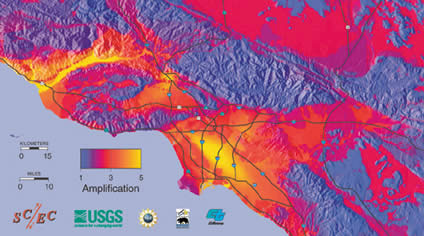|
Glossary of earthquake terms

Two important local geologic factors that affect the level of
shaking experienced in earthquakes are (1) the softness of the
surface rocks and (2) the thickness of surface sediments. This
image of the Los Angeles region combines this information to
predict the total amplification expected in future earthquakes
from local geologic conditions or "site effects."
The orange areas are the "hotspots" where this amplification
(not shaking) is anticipated to be highest. Shaking will ususally
be most intense near the rupturing fault in an earthqauke. (Data
for image courtesy of Harold Magistrale, San Diego State University;
Chris Wills, California Geological Survey; and Ned
Field, U.S. Geological Survey. Map created by Ned Field.)
|
Amplification
Most earthquakes
are relatively small, in fact, so small that no one feels them.
In order for seismologists to see the recording of the movement
of the ground from the smaller earthquakes, the recording has
to be made larger. It's like looking at the recording through
a magnifying glass, and the amount that it is magnified is the
amplification. Shaking levels at a site may also be increased
by focusing of seismic energy caused by the geometry of the sediment
velocity structure, such as basin subsurface topography, or by
surface topography.
|
|

